Moles are mostly associated with a friendly cartoon character, but for a gardener, they can be a real nightmare. Have you already noticed hummocks and holes in your yard? Don’t jump to conclusions, because there are at least two animals that can do the same for your beautiful garden.
As a pest control consultant, I’m going to help you with that. Whether you doubt you’re having a mole problem, let me give you a guide on recognizing and getting rid of ground moles.
Get to Know the Enemy
Moles are small mammals, weighing up to 120g. The length of their bodies is up to 16cm, covered with black fur, and the tail is up to 4cm max. These animals have small eyes that are also covered with fur, and ears that are not externally visible. Their front paws are armed with five strong long claws to dig the ground.
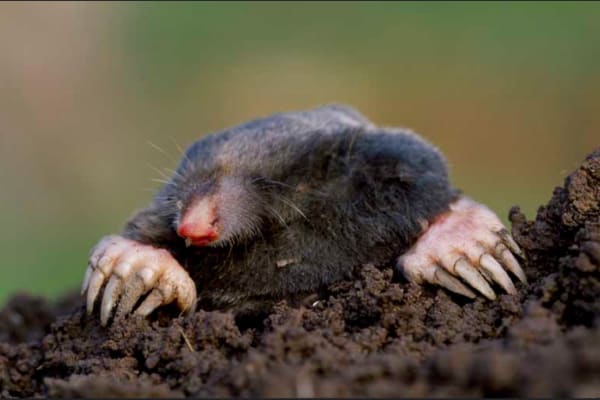
These animals have a rather good metabolism, so they require a large amount of food. Therefore, we provoke the appearance of moles by cultivating good soil in our gardens.
Here are the main reasons for a mole to settle in your property:
- The presence of loose earth in the beds and greenhouses. Besides, if the land is regularly watered and dug up, it is a perfect habitat for them;
- An abundance of food. Most garden pests lay eggs and larvae in the ground. Accordingly, the mole always has something to feed on;
- Lack of natural enemies. Most predators that are dangerous for moles avoid human habitation. Therefore, moles feel safe.
Moles do not have teeth like rodents, so they prefer to settle in soft soil. Their burrows are long enough, and sometimes they can cross small rivers and continue their work on the other side. During the night, the mole can dig a hole up to 50 m long.

The animals live alone most of the time, but during the breeding period, male and female individuals live in pairs to protect their offspring. Mating takes place in the spring, and the pregnancy of moles lasts 4-5 weeks. The female usually brings 5 to 10 cubs.
The first three weeks, they feed on mother’s milk, and after that, they begin to feed actively on the laid food trails. After a month, small moles begin to dig their own tunnels and equip their own nests. Thus, the destruction rate of your garden increases for at least five times. The average lifespan of a mole is up to 5 years.
There are different mole species you can meet in your garden:
- Eastern mole (Lat. Scalopus aquaticus);

This is the most widespread mole type you can meet. Actually, the eastern mole is the ordinary mole I’ve described above.
- Hairy-tailed mole (Parascalops breweri);
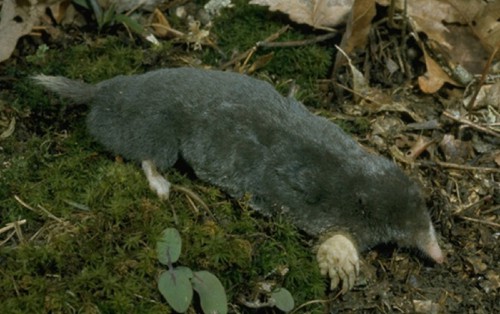
Its body is typically 116-140mm long, and the tail is 23-36mm. The weight of an individual is up to 40-86 grams. This mole also has thick and soft fur that covers its entire body (including the tail) with white spots on the chest and abdomen.
- Star-nosed mole (Condylura cristata).
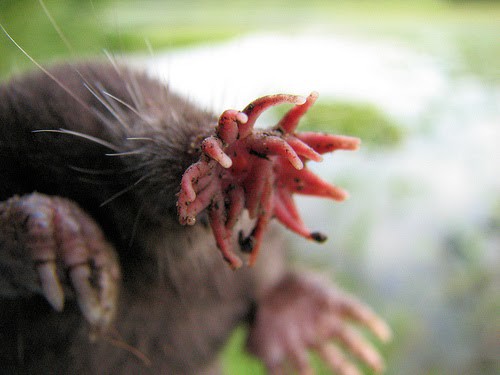
This mole is distinguished from other relatives by its muzzle. It has eleven skin growths around the nostrils that work as organs of touch. These things help to identify potential prey.
Regardless of the species, the mole eats plant roots or crops very rarely. It would prefer insects over vegetation. Potatoes and carrots are more likely to be eaten by mice than by moles.
On the one hand, a mole is an enemy (it spoils the landscape with emissions of earth and eats earthworms); on the other hand, it is a useful and necessary animal. Mole`s activity improves soil aeration and destroys harmful insects.
I’ve experienced some cases when after catching moles, there was a rapid increase in the number of chafers. Therefore, the farmers had to return moles to their territory. So it’s up to you whether to fight the moles in your area or to coexist with them peacefully.
Look, It’s a Mole… or Not?
Moles, voles, and gophers are the most widespread pests and most confusing animals for a gardener. However, the difference between them is more significant than you might think. Imagine that a small and nimble animal destroys your well-groomed lawn or yard.
Your gardener thinks this is a mole, your curious neighbor is sure that this is an ordinary vole, but you have a suspicion that you’re dealing with a gopher. How can you distinguish? And do you really need to? Of course, you do, since it is important to choose the right treatment.
How to Know that You Have a Mole Problem
Inspect the garden: is there loose soil and grass scattered across the surface? Do you see any mounds of earth with holes in the middle?
These are the clear signs that you have at least one mole in the yard. If you are lucky and can catch it, you will notice that the animal has large front paws, tiny eyes (moles are almost completely blind), and a very narrow muzzle.
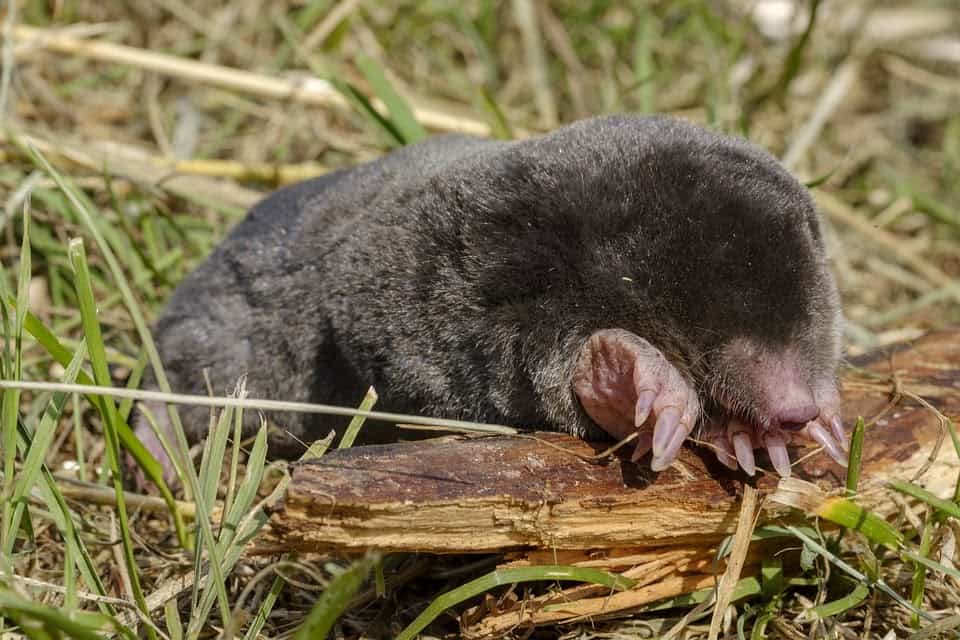
Mole vs Vole
These rodents tend to live in low-lying vegetation, for example, in flowerbeds and front gardens. If you ever noticed dead flowers or yellowish leaves and stalks, make sure to inspect your garden. When it comes to the appearance of voles, they can be confused with hamsters or rats, but they have shorter tails and long fur.
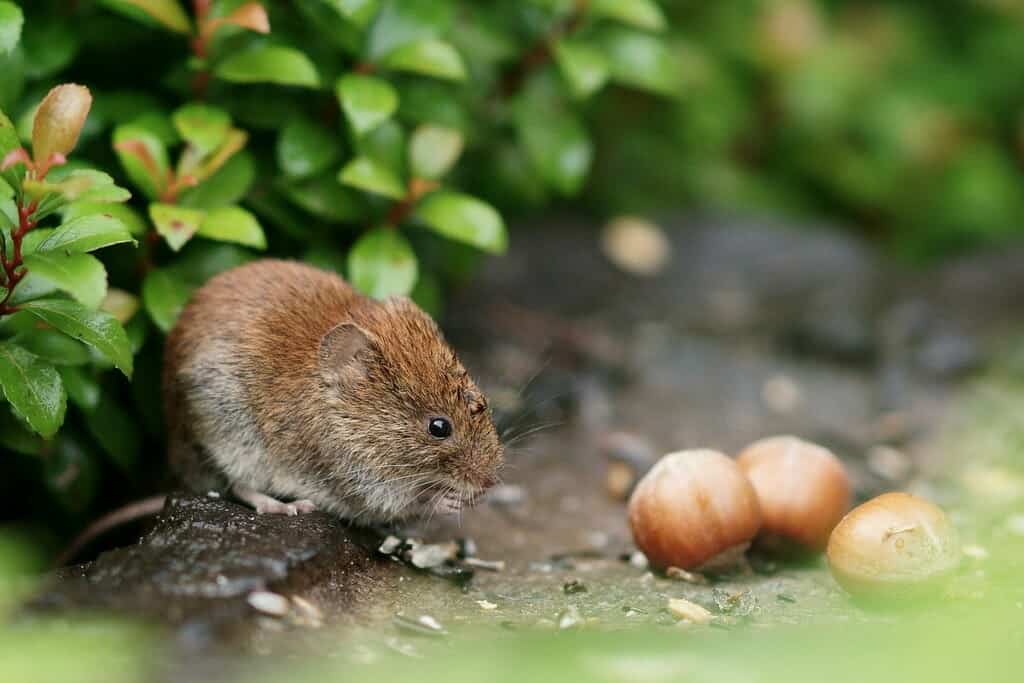
Mole vs Gopher
Gophers are animals with small eyes and long front teeth. They also dig tunnels like voles and moles, but these animals behave differently. Gophers cover the entrances of their burrows with soil. They do not live in families or communities and show up on the ground quite rarely.
Unlike moles, gophers aren’t blind. In addition, during the breeding season, gophers become very aggressive and may attack other animals or humans if they feel danger.
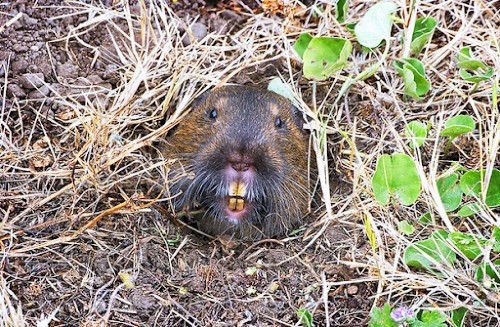
Are the Moles Really Dangerous?
Some people say that moles aren’t really that bad for your garden. Yes, they feed on insects that destroy your greenery, but the mole tunnels destroy the root systems of plants, which simply leads to their death. However, the reason that led the parasite to your garden is a will to help.
And although they do not eat your vegetation, they cause serious damage to plants with their numerous burrows:
- Moles dig mostly the upper layers of the soil, wrecking the roots and trunks of garden crops and trees. This leads to uprooting and dehydration. Thus, these mammals can kill a lot of fruit trees, shrubs, vegetables, and berries plants in a relatively short period.
- While processing a huge amount of soil, they mix low-fertile deep soil with the high-fertile surface. At the same time, they actively eat earthworms who are also destroyers of harmful nematodes microorganisms. As a result, the population of worms is greatly reduced, and the soil gradually becomes poor.
- Another harm of moles is their specific earthen mounds on the surface of the yard. As I have already mentioned, these signs of their indefatigable life spoil the appearance of the territory greatly. This is especially noticeable on well-groomed decorative lawns, tennis courts, or in the parking area.
You can drive out a mole with the help of modern technologies and folk remedies. Both of them are working, depending on the situation. The mole leaves for two to three months, just for the period of active plant growth. So, if you see the landslides scattered around your garden, don’t hesitate to take steps for mole control.
Choose the Best Way to Get Rid of Moles in Your Yard
Before you proceed to buy or make a DIY mole control product, make sure you’ve recognized mole damage to the yard.
Step 1: Examine Your Property
Moles spend almost their entire lives under the ground. So, when these animals get outside, they move helplessly on their twisted paws, trying to dig into the ground again as soon as possible.
In search of food, these pests constantly make tunnels, which are located in a loose and moist land at a depth of 2-5 cm. They feed during day and night, but at the dark time, they’re more active.
Step 2: Inspect Your Vegetation
Although these pests eat insects, they harm the plants unwittingly. If you see that your plants are dying or getting dry, make sure to look for mole trails.
Step 3: Monitor For Critters
To discover whether the tunnels are living mole spaces, you have to watch them. You can do it by following a simple method. When you examined the garden, get a shovel, and put some soil on the holes that are possible mole burrows exits. If the slides are destroyed, the mole is using these tunnels for feeding.
Step 4: Get Rid of Moles
Now, when you’re sure you have moles in your yard, you have to choose how to stop moles from destroying your property. There are plenty of treatments to select from.
However, there is no universal remedy for fighting moles. The animal lives deep underground and has a superbly developed sense of hearing, smell, and touch.
But in order to remove moles from yard forever, most homeowners are ready to experience DIY recipes, improvised tools, and not the most humane methods.
Mole Control Buyer’s Guide: Best Moles Control Remedies
Mole eradication is a process that needs time and proper products. Until now, catching pests has been the most effective method of getting rid of moles. I urge you to use mole traps and mole repellents that are designed specifically for moles and rodents for the best effect.
Searching for a solution, you will come across several types of the most effective mole control methods. Each of them is used depending on the number of moles and their activity.
For example, a scissor trap is the most effective for deep (or underground) mole tunnels. Harpoon traps are perfect for tunnels that run closer to the surface. And repellers are good for mole prevention and to exile the whole family.
To find out which product you need, let me give you a short guide on the products and practices I used to fight the moles. Check this list and find the most suitable one for you.
1. Best Castor Oil Mole Repellent: Nature’s Mace Mole Repellent 100% Castor Oil
[amazon box=”B01LWD8RAW” template=”vertical” tracking_id=”how-to-get-rid-of-moles-20″ button_text=”Check price on Amazon”]
Specifications:
- Item Form: Oil
- Item Volume: 32 Fluid Ounces
- Item Weight: 2.25 Pounds
- Package Dimensions: 4 x 4 x 12 inches
- Target Species: Mole and Vole
Castor oil is a very popular ingredient to deal with moles. The castor oil solution is also used for fertilizing flowers and plants. It deals with fungi, viruses, and pathogenic microorganisms that can destroy your greenery.
For moles, castor oil works as an odor-based repeller. For humans, the smell is almost elusive, but for these pests, it’s 100% effective. However, you have to use it correctly, so the result is not long from coming.
You can prepare your own product based on it, or save time and money by ordering a ready-made product. Nature’s Mace Mole Repellent is made from 100% organic and eco-friendly materials that will not only solve your mole problem but also benefit the soil.
How to use: Spread the repellent over the surface of your garden and wait for moles to leave in search of better habitat.
| Pros: | Cons: |
|
|
2. Check This Best Moles Killing Trap: Wire Tek 1001 EasySet Mole Eliminator Trap
[amazon box=”B06XTVMF4H” template=”vertical” tracking_id=”how-to-get-rid-of-moles-20″ button_text=”Check price on Amazon”]
Specifications:
- Material: Stainless Steel
- Number of Pieces: 2
- Item Weight: 5.5 Pounds
- Item Dimensions LxWxH: 10 x 4 x 6 inches
- Target Species: Mole
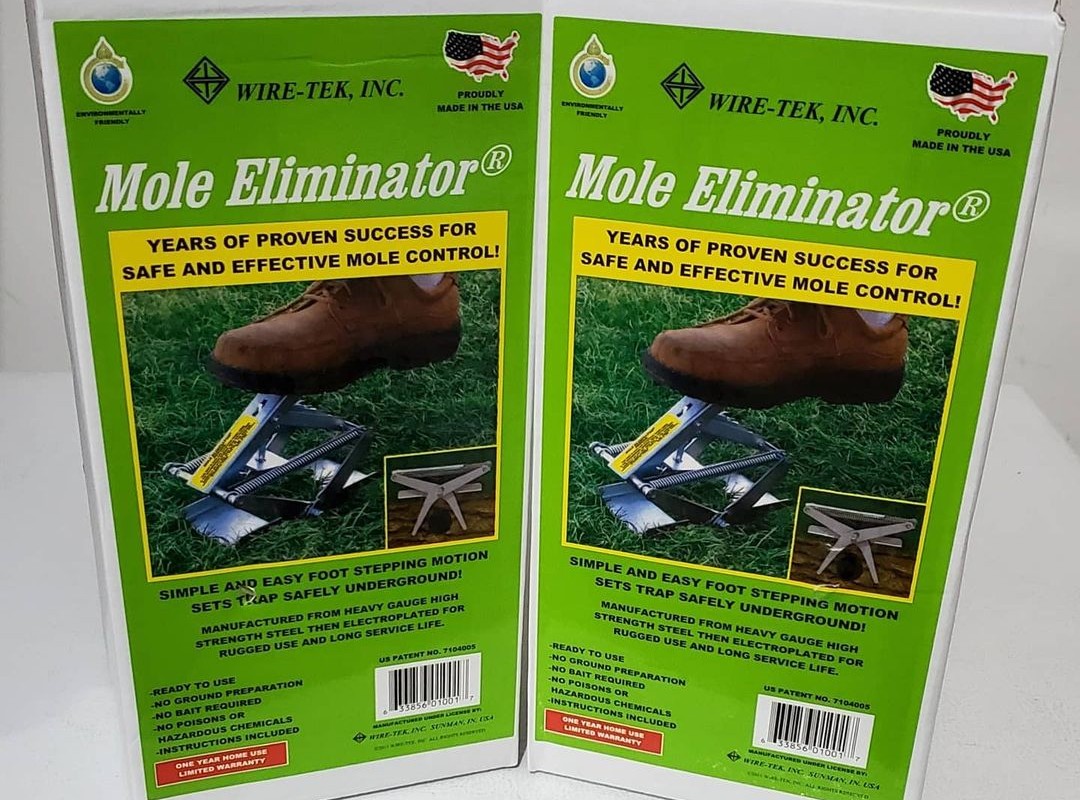
This type of ‘scissors’ trap does not leave moles a chance to survive. As soon as the mole gets between two panels of the device, it works instantly similar to the principle of a mousetrap. The Wire Tek 1001 EasySet Mole Eliminator Trap is one of the most popular products to fight moles if you don’t mind cruelty-free methods.
The manufacturer claims that these traps guarantee the result immediately, though, in fact, you’ll have to wait. Since the moles develop a whole network of tunnels underground, the chances that the animal will get into the installed trap are low enough.
If you ask me how to kill moles quickly, I would recommend EasySet Mole Eliminator Traps.
How to use: Find a mole tunnel, set a trap on both sides of the passage, and push its upper part to make it work. Once the mole gets into the trap, it’s dead.
| Pros: | Cons: |
|
|
3. Best Mole Poison to Buy: Bell Laboratories Talpirid 7150 Mole Bait Worms
[amazon box=”B003K2RYAY” template=”vertical” tracking_id=”how-to-get-rid-of-moles-20″ button_text=”Check price on Amazon” button_detail=”https://shareasale.com/r.cfm?b=410159&u=2583381&m=43235&urllink=www%2Edomyown%2Ecom%2Ftalpirid%2Dmole%2Dbait%2Dp%2D196%2Ehtml&afftrack=how%20to%20get%20rid%20of%20moles” button_detail_text=”Check price on DoMyOwn”]
Specifications:
- Active Ingredient: Bromethalin 0.02%
- Contains: 20 worm shaped baits two individually sealed trays of 10
- Item Weight: 0.32 ounces
- Product Dimensions: 6.9 x 1.2 x 12.4 inches
- Target Species: Moles only (will not work for gophers)
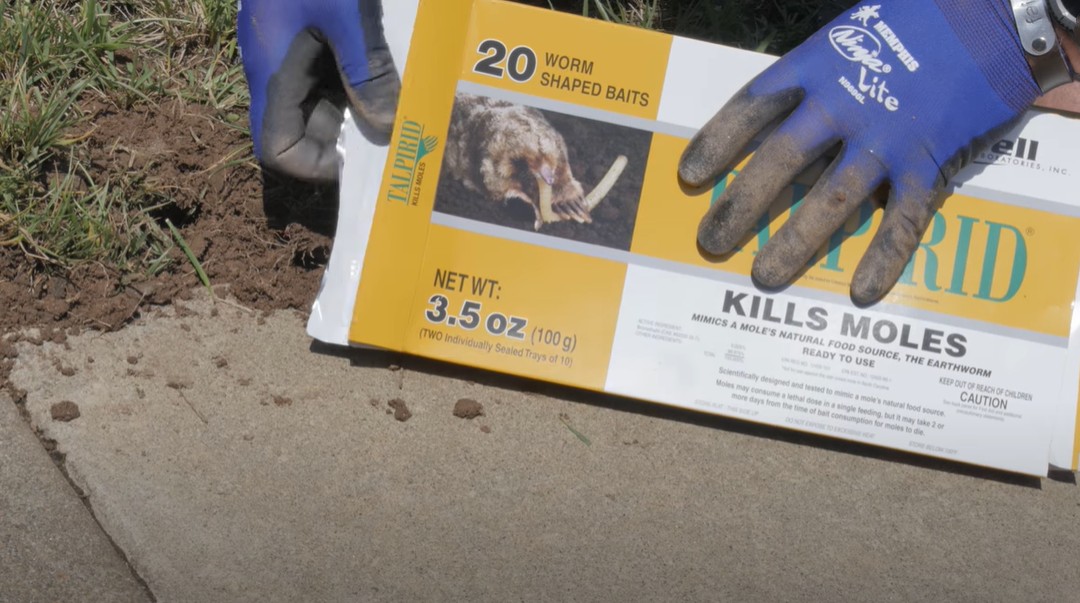
If we talk about the deadly types of methods to get rid of moles, let’s consider this option. These Bell Laboratories Talpirid mole baits look like worms, which are so enjoyed by moles. Inside every bait is a poison that kills the animal within 1-2 days.
Unlike the previous killing moles method, this option is less unpleasant to use. Not everyone likes to remove the dead body of the animal from the trap manually, but you can easily sweep it. To get the best effect, I recommend applying the bait worms on dry soil so the humidity won’t ruin the product`s features.
How to use: Use gloves to put the bait worms so they won’t mix with the humane smell that scares the moles. Avoid using it with any other chemical treatment or fertilizer.
| Pros: | Cons: |
|
|
4. Best Solar Powered Mole Repellent: Toro Products 4 Pack Mole Repellent
[amazon box=”B07T8CVR9Y” template=”vertical” tracking_id=”how-to-get-rid-of-moles-20″ button_text=”Check price on Amazon”]
Specifications:
- Color: Black
- Material: Plastic
- Number of Pieces: 4
- Item Weight: 1.43 pounds
- Package Dimensions: 15.3 x 3.15 x 3.75 inches
- Target Species: Mouse, Scorpion, Snake, Gopher, Mole

This ultrasonic pest repeller is an extremely effective way of controlling rodents and other garden vermins. If you’re into more humane ways of cleaning your yard from pests, this repellent is an excellent alternative to killing traps and mole poisons.
Toro Products ultrasonic repeller works using solar power, and as its name implies, it scares away moles with ultrasound. One repeller is usually enough for 10 acres. Its charging takes only 3-4 hours to work for 5 days.
The effectiveness of the repeller does not appear immediately, but it may take up to two weeks until the moles leave your garden completely. If you suffer from one individual, your garden will be free within 2-3 days. Warning: if the soil of your garden includes clay, the effectiveness of the treatment will be a little lower.
How to use: Place the repellers directly into the mole tunnel entrances.
| Pros: | Cons: |
|
|
5. Best Humane Mole Trap That Was Designed for Mice: CaptSure Original Humane Mouse Traps
[amazon box=”B07H2J2VTR” template=”vertical” tracking_id=”how-to-get-rid-of-moles-20″]
Specifications:
- Material: Plastic
- Size: Small
- Number of Pieces: 2
- Item Weight: 0.28 Pounds
- Item Dimensions LxWxH: 6.7 x 2.4 x 2.5 inches
- Target Species: Chipmunk, Mouse, Rat, Vole, Hamster, Mole
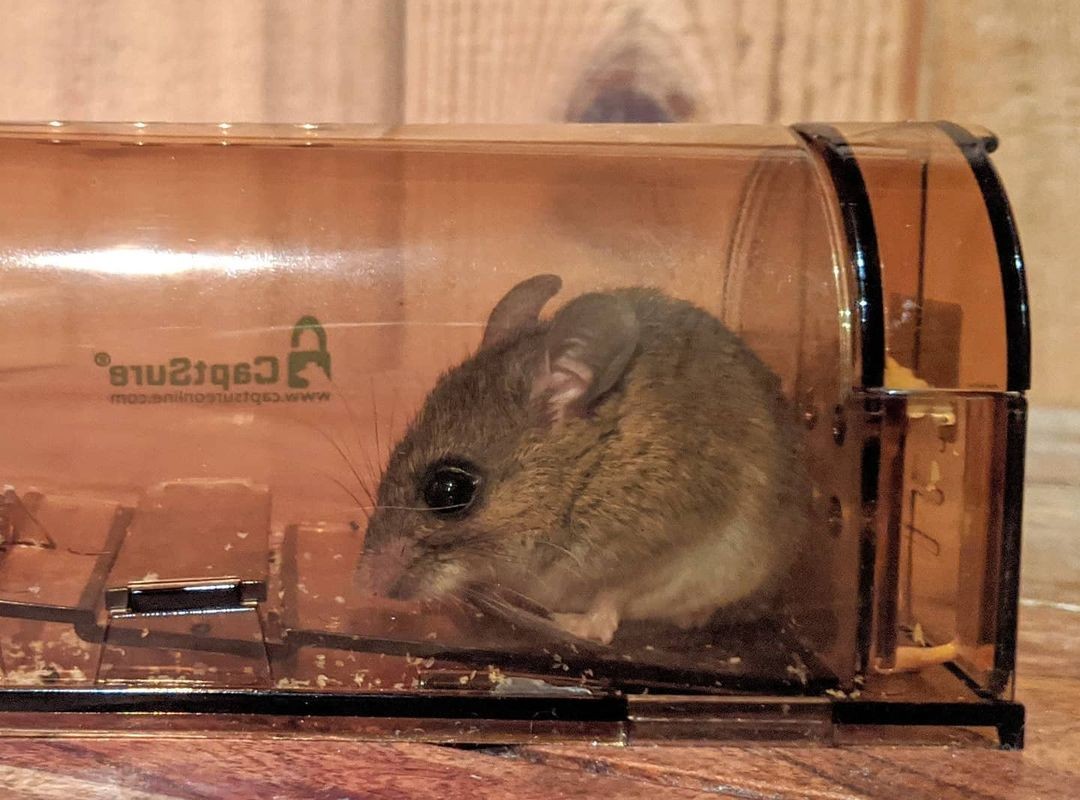
Traps for rats and mice can also help fight moles. If you do not trust repellers and other options or just want to know the enemy in person, use CaptSure Mouse Traps near the mole holes.
I do actually like this product due to the cruelty-free technology the manufacturer has used. All you have to do is to place the bait inside the trap and wait until the mole will find its way into it.
Remember that moles feed on earthworms, slugs, woodlice, insects and their larvae, millipedes, as well as spiders. So, you can easily find any lure in your garden. Well, this process isn’t pleasant if you don’t like dealing with insects.
The CaptSure traps are simple to install and use. They do not cause pain or any kind of tortures for a pest. It’s a rather humane mole removal method. Unlike most rodent traps, these are reusable since you can just wash them and use any time you need.
How to use: Open the bait compartment and place any type of insect inside. Place the traps near the molehills or inside the tunnel. Wait for some time and check whether the animal is inside.
| Pros: | Cons: |
|
|
Like I’ve already said, these products are proven to be effective in actual mole problem cases. If you feel like one of these treatments can be useful for you, check them out for more information.
DIY Options to Get Rid of Moles
DIY and alternative options are must-haves for any gardener. Of course, there are many ways how to get rid of moles in the yard naturally on the Internet. But let me give some examples I’ve heard about from my clients and fellows:
Make Some Noise
For this method, you need to take the reeds stems about two meters long. Clear the ‘insides’ and place a tube in the reed stalks. Then, stuck the device into the mole tunnel. The wind will make a sound, and since moles have a very developed hearing, it will annoy them.
It takes about a week or two for pests to leave your garden. However, keep in mind that this system works only during windy weather.
Bad Smell
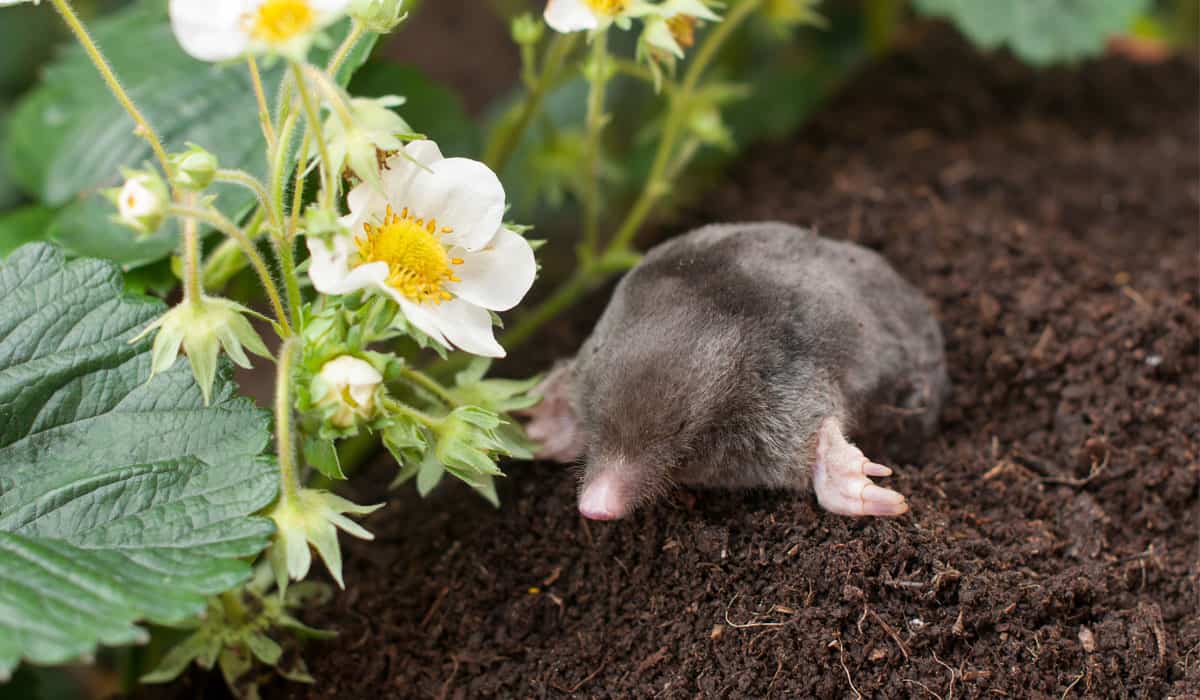
Plant a lot of onions, garlic, chili peppers, legumes, and onion flowers. Moles do not like the smell of these plants, so they will get away from the place. Watch the moles leave your garden in a hurry.
Guard Your Property
Dig hard materials along the entire perimeter of the garden to a depth of 70 centimeters. It’s better to choose linoleum, slate sheet, or tin. Due to their dense structure, they will not let animals settle in your yard.
Cataclysm
Flooding underground tunnels with poison aren’t something new to do. Although, this method can affect your soil very badly.
Catch the Bad Guy
This funny option can be called a pot trap. If you found a fresh molehill, dig a pot or a jar somewhere in the middle below its level. The animal will fall into it and get trapped with no harm.
How to Catch a Mole in Your Yard with a Shovel

Block the molehill entrance with a shovel. When the pest comes to repair the damaged passage, block the escape route using a second shovel, and take the third one to dig out the animal.
You need to understand that the effect of DIY catching moles lasts a week max. Moles spread very quickly. For example, a female that lives on the territory of 20 acres has enough to feed her family.
But a month later, when the cubs become independent, the adult mole chases them away, and they leave to look for a new territory where they can feed.
So, if you got rid of moles, it doesn’t mean you won’t meet them again. And as for me, these options consume too much time and energy for such a result.
How to Keep Moles out of Garden
Getting rid of moles requires a comprehensive and consistent approach. Blowing up a few tunnels or burying rotten fish heads in a bed won’t fix your problem. Trapping, scaring away, and destroying a mole are rather unpleasant measures that take a lot of time and effort as well. So, I believe that it is easier to prevent the problem.
After you successfully applied yard mole treatment and cleared your soil from their presence, it is so important to provide the protection of the garden. There are several methods to do it:
Metal Mesh around the Yard
Dig it for at least 1.2m deep around the perimeter of the garden. Moles do not go down so deep, so the method is very effective.
Horizontal Metal Mesh
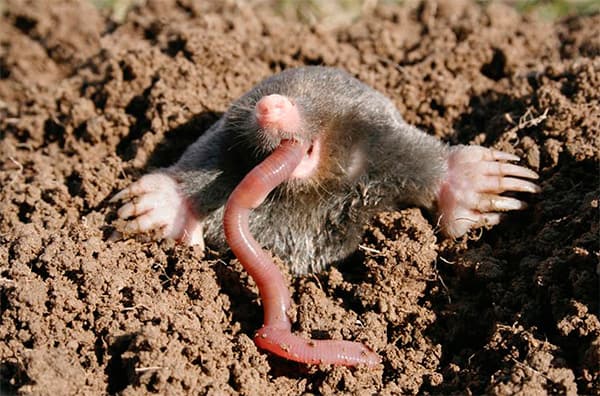
This option is suitable for small areas since the mesh has to be placed throughout the territory, which is very expensive for large areas. Deep it into the ground by 5-10 cm. When the mole finds its way to your yard, because of the mesh, it will not be able to dig, so the animal will choose a different direction.
High Nitrogen Plants
Choose any type of these plants including legumes, marigolds, tulips, or daffodils. Moles do not like nitrogen, so they won’t come to your property.
Houndstongue
Moles are not afraid of the smell of a plant, but of spiny seeds on its shoots. They cling to the skin of an animal and cause pain. This method protects your yard not only from moles but also from rodents.
FAQ

When Do Moles Come Out?
Moles are active through all seasons. If to speak about time, it depends on their metabolism. Moles feed every 3-4 hours, so they are constantly searching for food.
What Time of Day Are Moles Most Active?
Mostly, moles are active at night, but again, it depends on the animal’s need for food.
How Do I Control Moles in My Yard?
Let’s consider these steps as a common guide for getting rid of moles:
- Inspect your garden and learn whether you’re dealing with one or several moles;
- Find active mole tunnels and signs of mole damage to the yard;
- Choose the method to apply (or, maybe, you have to call a pest agency to get help);
- Guard your yard against the reappearance of moles.
Related Posts:
What Is the Fastest Way to Get Rid of Moles in Your Yard?
Well, I don’t think there is one. If you don’t have time to apply repellers or poisons, my recommendation to you is to call your local pest agency.
How to Get Rid of Moles Without Killing Them?
Use one of the cruelty-free products (see some examples that I like in the buyer’s guide above), or consider making a DIY solution.
How Many Moles Are in My Yard?
You can find out their number only by watching your garden. Get some non-killing traps, place them near the alleged molehills, and wait for a day or two.
How to Get Rid of Moles in Yard with Boric Acid?
Boron is an indispensable element for all garden crops. The use of boric acid allows you to increase the level of calcium intake of the plant, oxygen to the roots, increase the chlorophyll content in the green parts of the plant, and make berries and fruits sweeter.
It is also can be useful when fighting with moles. Get a boric acid solution and dip some baits into it. After that, place baits inside the mole tunnels.

How to Get Rid of Moles in Garden: General Thoughts
As you can see, it is not difficult to get rid of moles in the yard. The main thing is to handle this task wisely and humanely. However, is it worth it to kick the moles out forever? Whether you want to remove moles from your yard or not – this is a question you have to think over.
While moles can help to fight the insect type of pests in your yard, their underground activities can become a threat for you and your harvest. So, you have to prevent their appearance or use effective ways to fight the pests.
Regardless of which method you choose, make sure to follow the application instruction to get the best effect from the product. Also, don’t forget to identify the enemy first. There are two more similar pests that can also settle in your garden; therefore, the control means will be quite different.
By the way, have you already tried any of the described mole eradication methods? Or, maybe you have your own recipes? I hope that this guide will help you to deal with your problem quickly and easily. If you still have any questions about eliminating moles, please, leave them in the comments section below.
References:
- Moles (PennState Extension):
https://extension.psu.edu/moles - About Moles (Mass Audubon):
https://www.massaudubon.org/learn/nature-wildlife/mammals/moles/about - Scalopus aquaticus (University of Museum of Zoology):
https://animaldiversity.org/accounts/Scalopus_aquaticus/ - Parascalops breweri hairy-tailed mole(University of Michigan Museum of Zoology):
https://animaldiversity.org/site/accounts/information/Parascalops_breweri.html - Condylura cristata star-nosed mole (University of Michigan Museum of Zoology):
https://animaldiversity.org/site/accounts/information/Condylura_cristata.html - Controlling Pocket Gophers (Oklahoma State University):
https://extension.okstate.edu/fact-sheets/controlling-pocket-gophers.html - Moles in the lawn(Michigan State University):
https://www.canr.msu.edu/news/moles_in_the_lawn - Living with wildlife: Moles (Washington Department of Fish and Wildlife):
https://wdfw.wa.gov/species-habitats/living/species-facts/moles - Boric Acid (National Pesticide Information Center):
http://npic.orst.edu/factsheets/boricgen.html

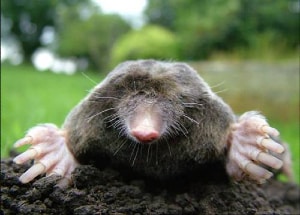
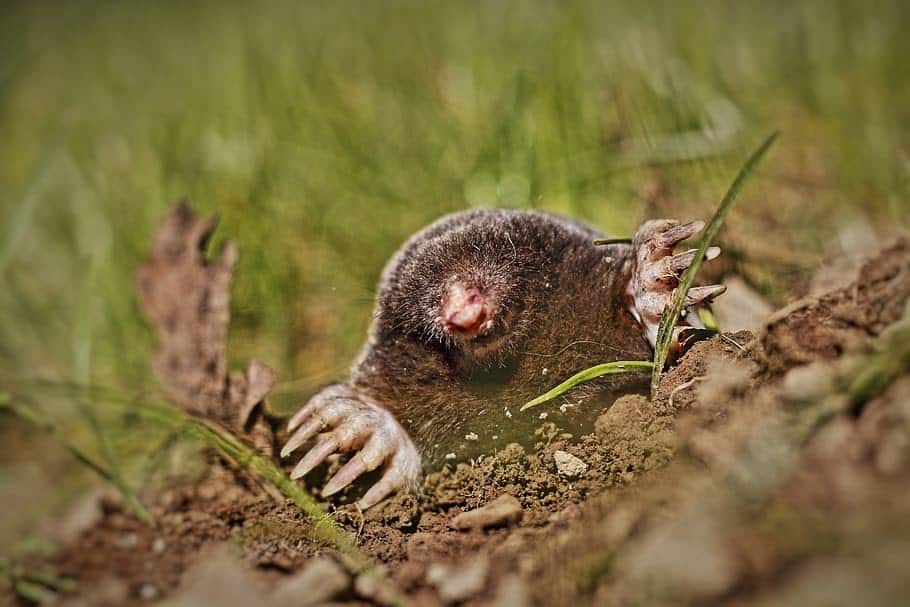
Comments are closed.